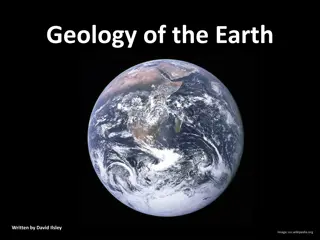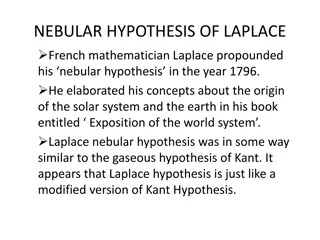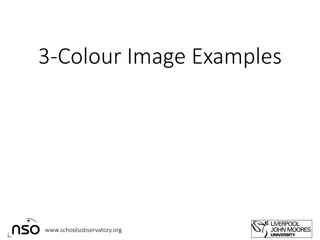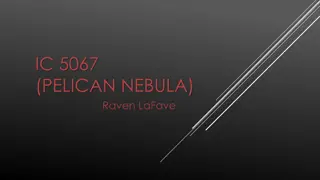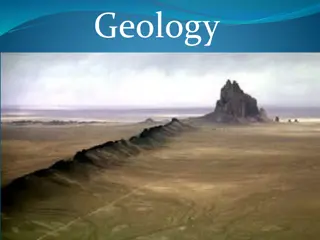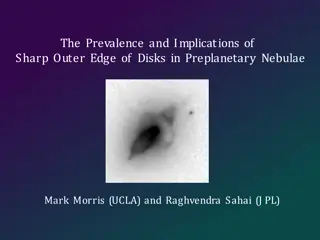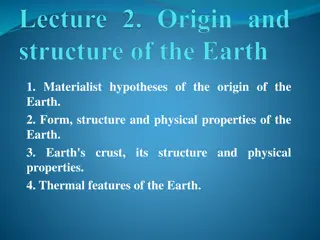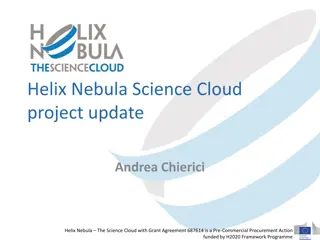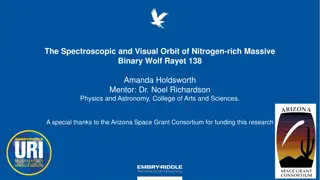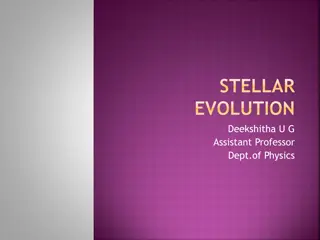Understanding Nebulae: From Kant's Proposal to Hubble's Discoveries
In 1755, Kant proposed that nebulae are island universes, sparking a debate on their nature within or outside our galaxy. Shapley and Curtis debated whether spiral nebulae were rotating systems like our Milky Way. Hubble's observations of the Andromeda Nebula led to the realization that it is a gala
10 views • 166 slides
The History of the Earth
The Earth, 4.5 billion years old, emerged from a nebula in the Milky Way Galaxy. Gravity led to the condensation of a rotating cloud into the Sun and planets. Over time, lumps collided, forming gas giants, rocky planets, and asteroids. The outer planets attracted hydrogen and helium, while the inner
2 views • 45 slides
Geology of the Earth
The evolution of elements in the universe began with the Big Bang, leading to the formation of hydrogen, helium, and heavier elements through stellar processes like fusion and supernovae. Our solar system formed 4.5 billion years ago from a nebula containing a variety of elements. These elements pla
4 views • 44 slides
Laplace's Nebular Hypothesis: Origin of the Solar System
French mathematician Laplace proposed the nebular hypothesis in 1796, refining Kant's gaseous hypothesis. Laplace asserted a hot rotating gaseous nebula cooled gradually, contracting and increasing rotation speed. Eventually, centrifugal forces led to the formation of ring structures, contrasting wi
0 views • 6 slides
Stunning Images of Nebulas and Galaxies from Schools Observatory
Explore mesmerizing images of Triangulum Galaxy, Bubble Nebula, Crab Nebula, Eskimo Nebula, Dumbbell Nebula, and Eagle Nebula captured by Schools Observatory. Each image showcases the beauty and intricacy of space, inviting viewers to marvel at the wonders of our universe. Immerse yourself in the co
0 views • 7 slides
Exploring IC 5067: The Pelican Nebula and Herbig-Haro Objects
Delve into the beauty and mysteries of IC 5067, the Pelican Nebula, located in the Cygnus constellation. Discover its unique features, including emission nebula jets emitted by Herbig-Haro object 555. Follow the imaging process using a Meade LX200 telescope and ST-9XE camera. Uncover the challenges
0 views • 11 slides
Exploring the Fascinating World of Geology and Earth Sciences
Delve into the diverse field of geology, covering topics such as physical and historical geology, geochronology, mineralogy, petrology, and more. Learn about the solar nebula hypothesis and the Earth's lithosphere, hydrosphere, atmosphere, and biosphere. Discover the composition of Earth's atmospher
0 views • 12 slides
The Prevalence and Implications of Sharp Outer Edge of Disks in Preplanetary Nebulae
Recognizable preplanetary nebulae typically exhibit bipolar structures with an opaque disk that contains a density discontinuity at a certain radius. These disks, when appropriately tilted, can block light from the rear lobe of the nebula, leading to the observation of a sharp outer boundary. Studie
0 views • 17 slides
Journey Through Earth's Formation and Evolution
Explore the origins of the Earth through the Big Bang Theory, Nebula Theory, Iron Catastrophe, and Formation of the Moon. Learn about Earth's layers, Pangea supercontinent, and the fascinating processes that shaped our planet over billions of years.
0 views • 7 slides
Hypotheses on the Origin of Earth and Earth's Formation
Various materialist hypotheses proposed by scientists such as Kant, Laplace, Schmidt, and Fesenkov regarding the origin of Earth and the solar system. These hypotheses suggest different processes, including the formation from primary dusty matter, hot nebula, interstellar meteorite dust, and gas-dus
0 views • 16 slides
The Complicated Formation of Earth's Water: A Detailed Overview
Jun Wu and colleagues at Arizona State University have developed a comprehensive model to explain the origin of Earth's water through stages such as planetary accretion, core formation, and interactions with the solar nebula. By tracing the isotopic composition of hydrogen, they explore how water so
0 views • 7 slides
Unveiling Dark Nebulae and Stellar Formation in Space
Dark Nebulae like the Coalsack Nebula and Snake Nebula are dense interstellar clouds where light cannot pass through. Comprised of tiny dust particles coated in frozen gases, they serve as precursors to stellar nurseries, where protostars begin to form and evolve. Learn about these enigmatic cosmic
0 views • 11 slides
Incredible Images Captured by the Hubble Space Telescope
The Hubble Space Telescope, launched in 1990, is the first of the four Great Observatories. It has captured breathtaking images of celestial wonders including the Cat's Eye Nebula and two galaxies colliding. The telescope's remarkable capabilities are showcased in these mesmerizing visuals, demonstr
0 views • 10 slides
Helix Nebula Science Cloud Project Overview
Helix Nebula Science Cloud project, funded by H2020, involves a Joint Pre-Commercial Procurement by various procurers like CERN and CNRS. The project phases include preparation, analysis, and pilot platform development. Contractors like RHEA and T-SYSTEMS are involved in providing cloud solutions. I
0 views • 10 slides
Studying Wolf-Rayet Stars: The Spectroscopic and Visual Orbit of WR 138
Wolf-Rayet (WR) stars are evolved, massive stars with their outer hydrogen envelopes stripped away, leading to strong stellar winds. Understanding these nitrogen-rich, carbon-rich, and oxygen-rich WR stars is crucial in unraveling their formation and contribution to nebula creation. This research de
0 views • 10 slides
Journey of a Star: Stellar Evolution Explained
Explore the stages of stellar evolution, from the birth of a protostar in a nebula to the dramatic transformations leading to the formation of red giants, white dwarfs, and black dwarfs. Understand phenomena like gravitational collapse, temperature changes, radiative processes, and the Chandrasekhar
0 views • 7 slides


